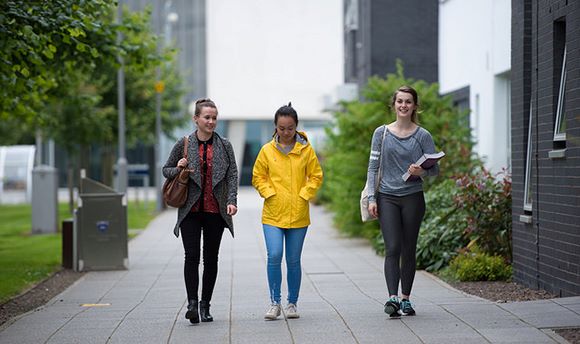IT and Learning Facilities
Learning Resource Centre (LRC)
The Learning Resource Centre (LRC) is a key space for staff, students and researchers. Within the LRC we offer a library service which is effective, dynamic, up-to-date and responsive to the needs of its users.
There are a wide range of services available, including information relating to borrowing, study skills, databases, e-journals and e-books through the Library (LRC) website
There is a wide range of learning, teaching and research services within the LRC including
- networked computer terminals
- full wireless access
- group study rooms
- quiet study rooms
- a postgraduate only study room, with two additional side rooms for reading or study
- self-service machines for the issue and return of books and to check your library account
- laptop loan and charging cabinets
- printing and photocopy facilities (including colour)
The HelpDesk (situated just inside the LRC) also deals with all student IT enquiries.
The LRC can be found to the right-hand-side of the main entrance on level 1. Remember, you will need your smartcard to gain access to lending facilities. The LRC is open 24 hours a day, 7 days a week. Staffing hours for the library
For further information on Library services please refer to the Library website or contact lrchelp@qmu.ac.uk
CANVAS
Canvas QMU's virtual learning environment. Many of your modules will have their own area in the Canvas. Amongst other resources, the module site contains:
- Course materials
- Online tests
- Group discussions
- Links to learning resources
- Submission drop-boxes for your assignments
- Plagiarism checking tool using Turnitin
- Asynchronous Lectures
- Synchronous Online Seminars
Information about how to access the Canvas, which includes an introductory video. Details regarding the Canvas/Blackboard mobile app.
ePortfolio
The ePortfolio is the perfect place to keep evidence of the work that you do while you are studying here at QMU.
Upload assets, reflections, complete worksheets and logbooks and store them in your portfolio which is your own personal space.
Get into the habit of reflective practice and keep a personal Blog to remind you of your time at the University.
Everything in the ePortfolio is private and only viewable by you, unless you choose to share the content you have been working on.
When you graduate from the University you can take your Portfolio away with you too! Further information on Pebblepad
Accessing Your IT Account When Away from QMU
Information on how to log into the QMU network from off campus is available from the Working off Campus section on the Getting Started pages of the website
Logging into the network in this way will give you access to all applicable software, library resources and your files, as if you were logging in via thin client on campus.
What is thin-client? Instead of running applications locally on PCs, applications run centrally with only keyboard, video and mouse updates transmitted across the network. A thin client has no hard drive so your files are then stored centrally making them available from anywhere 24/7. A workstation therefore consists of a low power thin client, screen, keyboard and mouse.
What are the benefits of thin-client? Thin-client devices are by their nature low-power devices. This means that not only do they consume far less electricity than traditional computers; they also generate much less heat, reducing the need for artificial ventilation. Other benefits over conventional computer technology include streamlining of IT support, cost saving, better security.
Closure of IT Account
After you leave the University (to graduate, or if you withdraw), your IT account will be closed after six weeks.
This will ensure that you have time to view your results and transfer any important items.
Printing, Photocopying, Scanning – Multifunctional Devices (MFDs)
Printing, photocopying and scanning facilities are provided by MFD units. MFDs are located around the LRC and other key sites.
Students use their smartcards to pay for and release printing from the MFDs.



